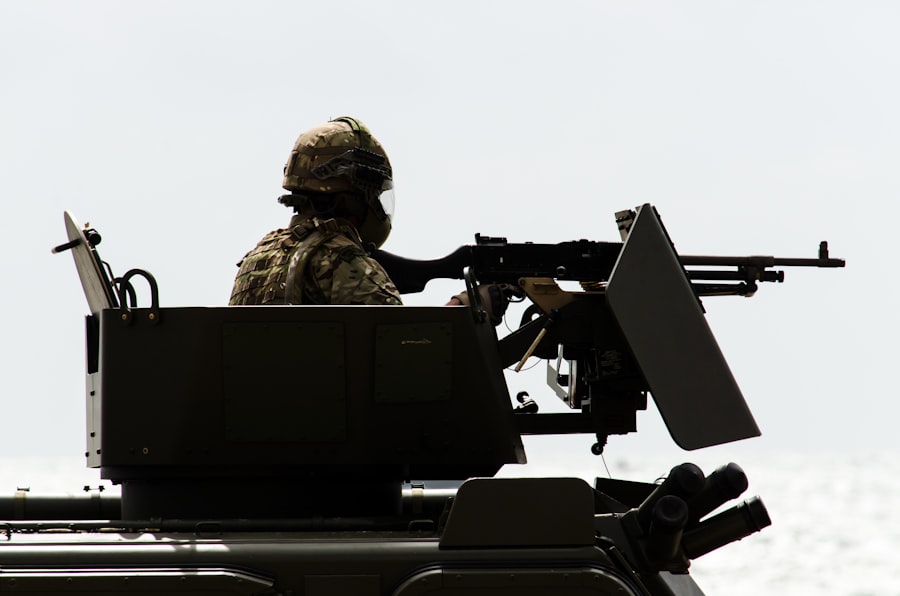Military spending has long been a focal point of national budgets, reflecting a country’s commitment to its defense and security. As nations navigate the complexities of global threats, the allocation of financial resources toward military capabilities has become increasingly intertwined with technological advancements. The evolution of warfare, driven by rapid technological progress, necessitates that military expenditures not only cover traditional defense needs but also invest in cutting-edge innovations.
This intersection of military spending and technology is crucial for maintaining a competitive edge in an ever-evolving geopolitical landscape. In recent years, the pace of technological change has accelerated dramatically, with advancements in artificial intelligence, cyber capabilities, and unmanned systems reshaping the battlefield. Countries are compelled to reassess their military budgets to ensure they are not only equipped with the necessary hardware but also the sophisticated technologies that enhance operational effectiveness.
The challenge lies in striking a balance between maintaining robust military capabilities and investing in the research and development of new technologies that can redefine modern warfare.
Key Takeaways
- Military spending and tech advancements go hand in hand, with advancements in technology driving the need for increased spending.
- Balancing military spending and tech advancements is crucial for maintaining a strong and efficient defense system.
- Technology has significantly impacted modern warfare, changing the way conflicts are fought and won.
- Military spending plays a vital role in ensuring national security and defense capabilities.
- Finding the right balance between military spending and tech advancements poses challenges but is essential for a strong and effective defense system.
The Importance of Balancing Military Spending and Tech Advancements
Striking a balance between military spending and technological advancements is essential for any nation seeking to safeguard its interests. Excessive focus on one aspect at the expense of the other can lead to vulnerabilities. For instance, a military that invests heavily in traditional weaponry without embracing new technologies may find itself outmatched by adversaries who leverage advanced systems.
Conversely, an overemphasis on technology without adequate funding for personnel and infrastructure can result in a hollow force that lacks the capacity to execute complex operations effectively. Moreover, balancing these two elements is not merely a matter of resource allocation; it also involves strategic foresight. Military leaders and policymakers must anticipate future threats and challenges while ensuring that their forces are equipped to respond effectively.
This requires a comprehensive understanding of both current capabilities and emerging technologies, as well as a willingness to adapt to changing circumstances. By fostering a culture of innovation within military organizations, nations can better position themselves to respond to unforeseen challenges while maximizing the effectiveness of their military spending.
The Impact of Technology on Modern Warfare

The impact of technology on modern warfare cannot be overstated. Innovations such as drones, cyber warfare capabilities, and advanced surveillance systems have transformed how conflicts are conducted. Drones, for example, have revolutionized reconnaissance and strike operations, allowing for precision targeting with minimal risk to personnel.
This shift has not only changed tactical approaches but has also raised ethical questions regarding the use of unmanned systems in combat. Cyber warfare represents another significant technological advancement that has altered the landscape of military engagement. Nations now face threats not only from conventional forces but also from cyberattacks that can disrupt critical infrastructure and compromise national security.
The ability to conduct offensive and defensive cyber operations has become a vital component of modern military strategy, necessitating substantial investment in cybersecurity measures and capabilities. As technology continues to evolve, militaries must remain agile and adaptable, integrating new tools and methodologies into their operational frameworks.
The Role of Military Spending in National Security
| Country | Military Spending (in billions) | Active Military Personnel | Number of Tanks |
|---|---|---|---|
| United States | 732 | 1,400,000 | 6,287 |
| China | 261 | 2,035,000 | 13,050 |
| Russia | 65.1 | 1,013,628 | 21,932 |
| India | 71.1 | 1,444,000 | 4,292 |
Military spending plays a pivotal role in ensuring national security, serving as a deterrent against potential aggressors while providing the means to respond to crises. A well-funded military is better equipped to maintain peace and stability, both domestically and internationally. This financial commitment reflects a nation’s priorities and its willingness to invest in the safety of its citizens and allies.
However, the effectiveness of military spending is contingent upon how resources are allocated. It is not enough to simply increase budgets; nations must ensure that funds are directed toward areas that enhance their strategic capabilities. This includes investing in personnel training, infrastructure maintenance, and technological advancements that can provide a competitive edge.
By aligning military spending with national security objectives, countries can create a robust defense posture that deters aggression while being prepared for any eventuality.
Challenges in Balancing Military Spending and Tech Advancements
Balancing military spending with technological advancements presents several challenges for policymakers. One significant hurdle is the rapid pace of technological change, which can outstrip budgetary processes and planning cycles. As new technologies emerge, military leaders must make difficult decisions about which innovations to prioritize while ensuring that existing capabilities are maintained.
This often leads to debates within governments about resource allocation and strategic priorities. Additionally, there is the challenge of bureaucratic inertia within military organizations. Established practices and procurement processes can hinder the swift adoption of new technologies, resulting in missed opportunities for modernization.
Resistance to change can stem from various factors, including institutional culture, risk aversion, and the complexities of integrating new systems into existing frameworks. Overcoming these challenges requires strong leadership and a commitment to fostering an environment that encourages innovation and adaptability.
Strategies for Prioritizing Tech Advancements in Military Budgets

To effectively prioritize technological advancements within military budgets, nations can adopt several strategies. First, establishing dedicated research and development funds can ensure that innovative projects receive the necessary financial support without competing with traditional defense expenditures. By creating a separate budget line for R&D, governments can signal their commitment to fostering innovation while maintaining operational readiness.
Another strategy involves fostering partnerships with private industry and academic institutions. Collaborating with technology companies can accelerate the development and integration of cutting-edge solutions into military operations. Public-private partnerships can leverage the expertise and agility of the private sector while providing military organizations with access to emerging technologies that may not be available through traditional procurement channels.
Examples of Successful Integration of Technology in Military Operations
Numerous examples illustrate the successful integration of technology into military operations across various nations. The United States military’s use of drones for surveillance and targeted strikes has become a hallmark of modern warfare, demonstrating how unmanned systems can enhance operational effectiveness while minimizing risks to personnel. These systems have been employed in various theaters, providing real-time intelligence and precision targeting capabilities that have reshaped combat strategies.
This system employs sophisticated radar and interception technologies to detect and neutralize incoming missiles, significantly reducing casualties during conflicts. The success of such systems underscores the importance of investing in technological advancements that enhance national security while also demonstrating the potential for innovation to save lives.
Potential Risks of Neglecting Tech Advancements in Military Spending
Neglecting technological advancements in military spending poses significant risks for nations seeking to maintain their defense capabilities. As adversaries invest in cutting-edge technologies, countries that fail to keep pace may find themselves at a strategic disadvantage. This could lead to vulnerabilities that adversaries could exploit, undermining national security and potentially emboldening hostile actions.
Moreover, neglecting tech advancements can result in outdated operational practices that hinder effectiveness on the battlefield. In an era where speed and adaptability are paramount, militaries that rely on legacy systems may struggle to respond effectively to dynamic threats. This stagnation can erode confidence among allies and diminish deterrence capabilities, ultimately compromising national security interests.
The Role of Research and Development in Military Innovation
Research and development (R&D) play a crucial role in driving military innovation and ensuring that armed forces remain at the forefront of technological advancements. By investing in R&D initiatives, nations can explore new concepts, test emerging technologies, and develop solutions tailored to specific operational needs. This proactive approach enables militaries to anticipate future challenges rather than merely reacting to them.
Furthermore, R&D fosters a culture of innovation within military organizations. Encouraging collaboration between scientists, engineers, and military personnel can lead to breakthroughs that enhance operational capabilities. By prioritizing R&D within military budgets, nations can cultivate an environment where creativity thrives, ultimately leading to advancements that redefine modern warfare.
The Future of Military Spending and Tech Advancements
The future of military spending will likely be characterized by an increasing emphasis on technology as nations grapple with evolving threats and challenges. As geopolitical dynamics shift and new adversaries emerge, countries will need to adapt their defense strategies accordingly. This adaptation will necessitate a reevaluation of budget priorities, with a focus on integrating advanced technologies into military operations.
Moreover, as artificial intelligence continues to advance, its implications for warfare will become more pronounced. Nations will need to invest in AI-driven systems that enhance decision-making processes, improve situational awareness, and optimize resource allocation on the battlefield. The integration of AI into military operations will require careful consideration of ethical implications while ensuring that human oversight remains paramount.
Finding the Right Balance for Military Spending and Tech Advancements
In conclusion, finding the right balance between military spending and technological advancements is essential for ensuring national security in an increasingly complex world. As nations navigate the challenges posed by evolving threats, they must prioritize investments that enhance both traditional defense capabilities and innovative technologies. By fostering a culture of innovation within military organizations and embracing collaboration with private industry, countries can position themselves for success on the modern battlefield.
As technology continues to reshape warfare, nations must remain vigilant in their efforts to integrate new solutions while maintaining robust defense postures. By doing so, they can safeguard their interests while contributing to global stability in an uncertain future.
In the ongoing debate over military budget allocations versus technological innovation, it’s crucial to consider how resources are distributed to maintain a balance between immediate defense needs and long-term technological advancements. An insightful article on this topic can be found on the website “In The War Room.” The article discusses the intricate relationship between defense spending and the development of cutting-edge technologies that could redefine future military capabilities. For a deeper understanding, you can read more about this in the article available at In The War Room. This piece provides a comprehensive analysis of how strategic investments in technology can enhance military effectiveness while ensuring fiscal responsibility.
FAQs
What is the relationship between military budget and technological innovation?
The relationship between military budget and technological innovation is complex. On one hand, a higher military budget can provide the resources necessary to invest in and develop new technologies. On the other hand, technological innovation can also lead to more efficient and cost-effective military capabilities, potentially reducing the need for a larger budget.
How does military budget impact technological innovation?
A higher military budget can provide the necessary funding for research and development of new technologies, as well as the procurement of advanced equipment and systems. This can drive technological innovation in the defense sector and lead to the creation of cutting-edge military capabilities.
What are the potential drawbacks of a large military budget on technological innovation?
While a large military budget can support technological innovation, it can also lead to inefficiencies and a focus on maintaining existing systems rather than investing in new technologies. Additionally, a disproportionate focus on military spending may divert resources away from other areas of innovation and economic development.
How can technological innovation impact military budget?
Technological innovation has the potential to impact military budget by increasing the efficiency and effectiveness of military capabilities. Advanced technologies can lead to cost savings, improved performance, and reduced maintenance requirements, potentially allowing for a more effective military with a smaller budget.
What are some examples of technological innovations driven by military budgets?
Examples of technological innovations driven by military budgets include advancements in aerospace technology, such as stealth aircraft and unmanned aerial vehicles (drones), as well as developments in cyber security, missile defense systems, and advanced weaponry. These innovations have not only transformed military capabilities, but have also had broader impacts on civilian technology and industry.




